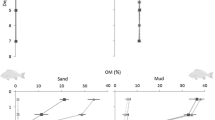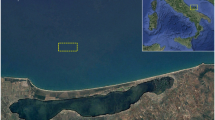Abstract
Measurements of pseudofaeces production of Dreissena polymorpha were carried out with the aim of developing a biological filter at the freshwater inlet of Lake Volkerak-Zoommeer, the Netherlands. Bioprocessing of polluted suspended matter by suspended cultures of D. polymorpha occurs by filtration and sedimentation of the suspended matter as pseudofaeces. The measurements were conducted under semi-natural conditions.
Pseudofaeces production was mainly determined by the dry matter content of the water; the relation is linear. Temperature was of much less importance. This agrees with earlier investigations of the filtration rate of D. polymorpha. Even at the lowest temperature measured during the experiments (6.4 °C) no large decrease in activity was observed. The relation of pseudofaeces production with shell length was sigmoid in shape, in accordance with measurements of the filtration rate.
The pseudofaeces produced was slightly more polluted than suspended matter, partly due to a finer grainsize. D. polymorpha from Lake IJsselmeer exposed for 217 days at the intended location of the filter showed bioaccumulation of toxicants, especially organic pollutants and Polycyclic Aromatic Hydrocarbons (up to 10-fold accumulation). The required number of D. polymorpha in the biological filter to treat the waterflow of 14 m3 s−1 entering Lake Volkerak-Zoommeer is 1.24 * 109. The purification efficiency of the filter, the reduction of the amount of toxicants, partly depends on the binding properties of the toxicants and is highest for those strongly bound to suspended matter.
Similar content being viewed by others
References
Buttner, J. K., 1986. Corbicula as a biological filter and polyculture organism in catfish rearing ponds. The Progressive Fish-Culturist 48: 136–139.
Bij de Vaate, A., 1991. Distribution and aspects of population dynamics of the zebra mussel, Dreissena polymorpha (Pallas, 1771), in the lake Usselmeer area (The Netherlands). Oecologia 86: 40–50.
Foster-Smith, R. L., 1975. The effect of concentration of suspension on the filtration rates and pseudofaecal production for Mytilus edulis L., Cerastoderma edule (L.) and Venerupis pullastra (Montagu). J. exp. mar. Biol. Ecol. 17: 1–22.
Jónasson, P. M., 1978. Zoobenthos of lakes. Verh. int. Ver. Limnol. 20: 13–37.
Jørgensen, C. B., T. Kiørboe, F. Møhlenberg & H. U. Riisgård, 1984. Ciliary and mucus net filter feeding, with special reference to fluid mechanical characteristics. Mar. Ecol. Progr. Ser. 15: 283–292.
Kharchenko, T. A. & A. V. Lyashenko, 1986. Destruction of allochthonous organic matter in canals in the presence of Dreissena. Gidrobiol. Zhurnal 21: 90–95.
Piesik, 1983. Biology of Dreissena polymorpha (Pall.) settling on stylon nets and the role of this mollusc in eliminating the seston and the nutrients from the water-course. Pol. Arch. Hydrobiol. 30: 353–361.
Reeders, H. H. (ed.), 1989. Een Biologisch Filter: haalbaar of niet? Evaluatie van de mogelijkheden voor de zuivering van inlaatwater van the Volkerak-Zoommeer met een driehoeksmosselfilter. Institute for Inland Water Management and Waste Water Treatment, report nr. 89.059.
Reeders, H. H., 1990. Hangcultures driehoeksmosselen (Dreissena polymorpha), eerste resultaten van onderzoek. Institute for Inland Water Management and Waste Water Treatment, report nr. 90.030.
Reeders, H. H., A. Bij de Vaate & F. J. Slim, 1989. The filtration rate of Dreissena polymorpha (Bivalvia) in three Dutch lakes with reference to biological water quality management. Freshwat. Biol. 22: 133–141.
Reeders, H. H. & A. Bij de Vaate, 1990. Zebra mussels (Dreissena polymorpha): a perspective for water quality management. Hydrobiologia 200/201: 437–450.
Salomons, W. & U. Forstner, 1984. Metals in the Hydrocycle. Springer-Verlag, Berlin.
Schulte, E. H., 1975. Influence of algal concentration and temperature on the filtration rate of Mytilus edulis. Mar. Biol. 30: 331–341.
Sprung, M. & U. Rose, 1988. Influence of food size and food quantity on the feeding of the mussel Dreissena polymorpha. Oecologia 77: 526–532.
Ten Winkel, E. H. & C. Davids, 1982. Food selection by Dreissena polymorpha Pallas (Mollusca: Bivalvia). Freshwat. Biol. 12: 553–558.
Walz, N., 1978a. The energy balance of the freshwater mussel Dreissena polymorpha Pallas in laboratory experiments and in Lake Constance. I. Pattern of activity, feeding and assimilation efficiency. Arch. Hydrobiol./Suppl. 55: 83–105.
Walz, N., 1978b. The energy balance of the freshwater mussel Dreissena polymorpha Pallas in laboratory experiments and in Lake Constance III. Growth under standard conditions. Arch. Hydrobiol. Suppl. 55: 121–141.
Walz, N., 1978c. The energy balance of the freshwater mussel Dreissena polymorpha Pallas in laboratory experiments and in Lake Constance IV. Growth in Lake Constance. Arch. Hydrobiol. Suppl. 55: 142–156.
Walz, N., 1978d. Growth rates of Dreissena polymorpha Pallas under laboratory and field conditions. Verb. int. Ver. Limnol. 20: 2427–2430.
Winter, J. E., 1978. A review on the knowledge of suspension-feeding in lamellibranchiate bivalves, with special reference to artificial aquaculture systems. Aquaculture 13: 1–33.
Author information
Authors and Affiliations
Rights and permissions
About this article
Cite this article
Reeders, H.H., Bij de Vaate, A. Bioprocessing of polluted suspended matter from the water column by the zebra mussel (Dreissena polymorpha Pallas). Hydrobiologia 239, 53–63 (1992). https://doi.org/10.1007/BF00027529
Accepted:
Issue Date:
DOI: https://doi.org/10.1007/BF00027529




